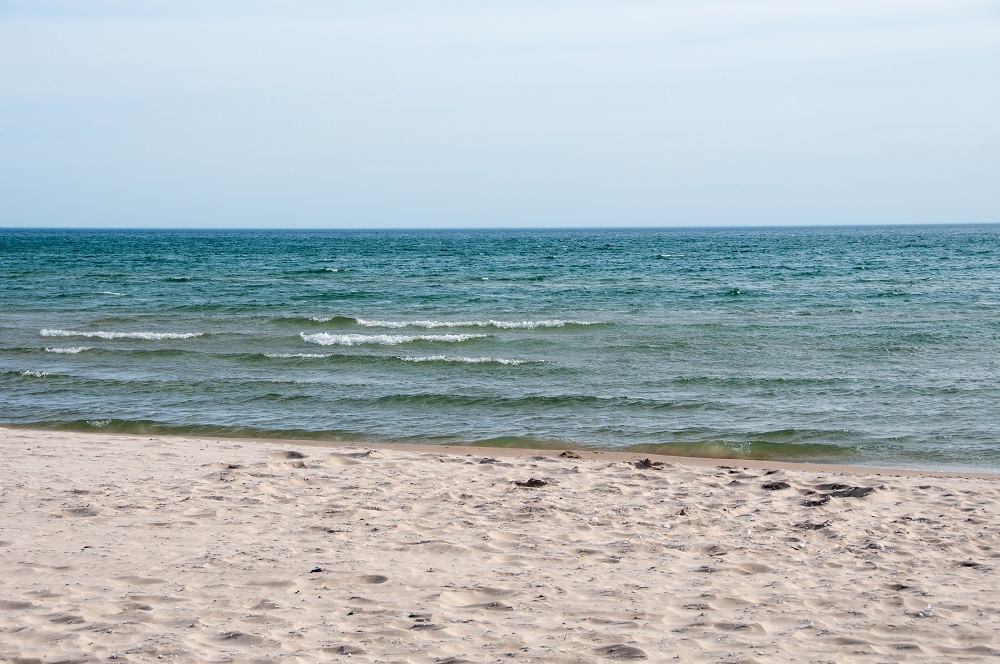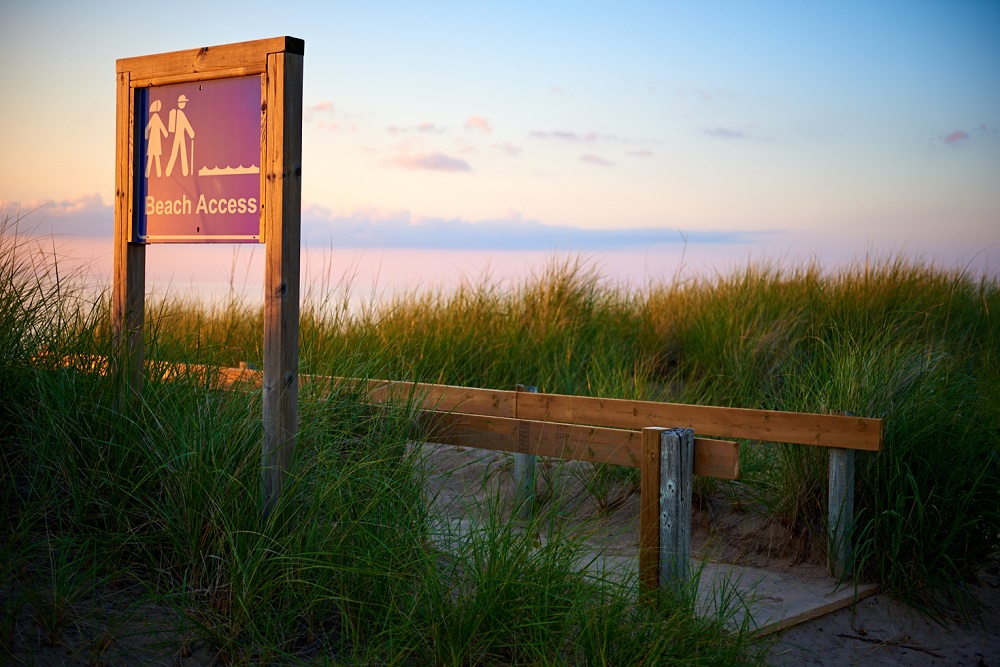Today’s blog was written by Jessica Stillman, school outreach coordinator at Bronte Creek Provincial Park.
Our beautiful beaches are one of the many reasons people choose to visit parks.
But you didn’t think they got that pretty on their own, did you?
Here’s a glimpse into some of the behind-the-scenes work you probably didn’t know was going on across the province…
Singin’ the blues
Visitors flock to see Lake Superior Provincial Park‘s pristine blue waters from their unique beaches.
While most of it is indeed natural, we do occasionally help the lake keep its world-renowned turquoise hues, especially near our beachfronts where visitors want the perfect picture of our largest Great Lake.
Once the ice melts each spring, staff outfit teams of canoers with large amounts of natural blue dye. These canoes paddle along the shorelines of Lake Superior Provincial Park, depositing the dye where necessary.
While these primary canoes disperse the blue dye, other canoers follow, using their paddles to mix the dye into the water.
This natural dye does not harm any of the wildlife in Lake Superior, however, local fishers have caught a number of fish that seem to be “unnaturally blue.”
Visitors are advised to not spend too much time swimming in Lake Superior, or they could find themselves exiting the water with a blue tint.
Thankfully, the lake’s cold water means visitors don’t typically spend enough time in the water to notice a difference.
Iconic dunes
Pinery Provincial Park’s beach is well-known for its three S’s — sand, sunsets, and sand dunes. But those sand dunes don’t just form themselves!
Pinery staff have already begun charging the batteries needed to complete their spring beach maintenance. Using industrial leaf blowers, staff reform the sand dunes along the beach that were damaged over the winter.
This work only happens during the spring once the snow has melted and migration has begun. This is because staff use the sounds of the migrating birds to cover up the noise from the leaf blowers.
It typically takes weeks to complete the work, as staff want the shape of the sand dunes to be as natural as possible.
Delays are not uncommon due to uncharged batteries, noise complaints, or unforeseen snow.
All the hard work is worth it though, as the sand dunes provide important habitat for park flora and fauna, a windbreak for beach goers, and an Instagram-worthy view of Lake Huron.
Next time you visit Pinery, remember to stay off the sand dunes as they take weeks of work to form, and maintenance on them only happens in the spring.
Lending a helping hand
New this year!
Wasaga Beach Provincial Park is introducing their very own on-beach equipment repair: the Wasaga Beach Helping Hands!
Is a knob on your barbecue a little squeaky? Does your umbrella block too much of the sun? Have your sand toys gotten a little too sandy? We’ve got just the solution for you!
Our jack-of-all-trades Helping Hands are here to… well, help!
We know that after a long day lying on the beach, the thought of bringing your used equipment back home with you seems like a bit too much work.
Instead of ditching your equipment in the sand or at a dumpster, stop at a newly-erected Helping Hands hut on your way out!
Our Helping Hands will bring your lightly used equipment back to its brand-new, out-of-the-package condition (for a nominal fee, of course)!
Our Helping Hands have built 14 individual huts across Wasaga Beach’s 14 km sandy shore to prepare for the upcoming season. That’s one hut per kilometre!
In between building huts, our Helping Hands have been training hard this spring to gain a very particular set of skills in repairs, most of which involve WD-40, duct tape, and itty-bitty sand brushes.
Keeping it natural
Visitors to Killbear Provincial Park have always been in awe of its rocky shoreline and sandy beaches.
From small pocket beaches to long stretches of sand, there is something for everyone!
Part of the appeal is that no two beaches are exactly the same. Some beaches have coarse yellow sand, others fine white sand. If you look closely, you can even find pocket beaches with pink and black sand!
So, how does Killbear maintain their variety of sandy beaches? With a rock tumbling machine, of course!
A rock tumbling machine is like a very large washing machine. Put rocks into the machine, select your desired sand size, and hit start.
After 24 hours of tumbling, spinning, and bumping into each other, the rocks breakdown into sand.
The colour and type of rocks used results in different types of sand. Back in 1994, the staff member in charge of the rock tumbler thought it would be funny to make each of the beaches have slightly different sand.
That year resulted in the most positive camper comments about the quality of the beach sand, and ever since then, Killbear has continued to make their beaches all have slightly different sand to satisfy all their visitors’ needs!
Trucking the good stuff
Presqu’ile Provincial Park welcomes hundreds of thousands of visitors to its 2.5 km sandy shoreline each year.

While visitors are busy frolicking in Lake Ontario, the lake is slowly washing away the sand from Presqu’ile’s beaches, moving east to be deposited at North Beach Provincial Park and Sandbanks Provincial Park.
Now, don’t get us wrong, this is great for these other popular beach parks, and we’re super happy for them, but it doesn’t bode well for the beaches at Presqu’ile.
To remedy the issue, each spring Ontario Parks staff move truckloads of sand from North Beach and Sandbanks back to Presqu’ile where it came from.
So much sand accumulates each year, that moving truckloads of it back to Presqu’ile isn’t noticeable to North Beach and Sandbanks visitors.

Staff know the difference all that sand makes in restoring Presqu’ile’s beach.
This makes the hard work worth it, as staff also know all the sand they move each spring will soon return to North Beach and Sandbanks via Lake Ontario again.
Without spring beach maintenance, Presqu’ile’s beach could one day cease to exist.
April Fool’s!
Spring maintenance is in fact underway in many of our provincial parks as we gear up for summer, but BEACH maintenance isn’t quite as we described.
We like to leave most of that up to nature.
Lake Superior’s blue waters are all natural — no staff intervention required! Especially on sunny days, some might mistake a sandy beach along Lake Superior for a Caribbean getaway!
Pinery does have all the S’s – sand, sunsets, and sand dunes, but nature forms the sand dunes without staff involvement. You can help protect the dunes by staying off them during your visit!
While Wasaga Beach hasn’t employed Helping Hands, staff work hard to collect lost items and garbage from the beach to maintain it for wildlife and visitors.
You can do your part by leaving your beach area as you found it or better yet, even cleaner than when you arrived! Visiting the beach for just the day or weekend? Borrow equipment from a friend or family member.
Killbear does have small and large beaches with a variety of types of sand. The variance in the colour and texture of the sand is actually due to the rocky shoreline and Georgian Bay storms moving sand around.
Presqu’ile’s sand is, in fact, slowly being moved to North Beach and Sandbanks by Lake Ontario, but Prequ’ile’s beach will also be getting deposits of sand from other places further west.
We love our beaches, and we know you do too!
Thank you for helping us keep our beaches pristine.












